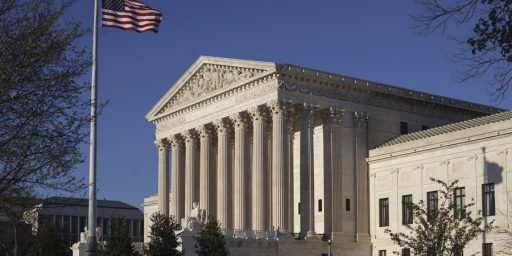SUPREMES MIXED ON MICHIGAN CASES
WaPo reports In Split Decision, Court Backs Affirmative Action:
In two split decisions, the Supreme Court on Monday ruled that minority applicants may be given an edge when applying for admissions to universities, but limited how much a factor race can play in the selection of students.
The high court struck down a point system used by the University of Michigan, but did not go as far as opponents of affirmative action had wanted. The court approved a separate program used at the University of Michigan law school that gives race less prominence in the admissions decision-making process.
The Constitution “does not prohibit the law school’s narrowly tailored use of race in admissions decisions to further a compelling interest in obtaining the educational benefits that flow from a diverse student body,” Justice Sandra Day O’Connor wrote.
Well, actually, it does:
Section 1. All persons born or naturalized in the United States, and subject to the jurisdiction thereof, are citizens of the United States and of the state wherein they reside. No state shall make or enforce any law which shall abridge the privileges or immunities of citizens of the United States; nor shall any state deprive any person of life, liberty, or property, without due process of law; nor deny to any person within its jurisdiction the equal protection of the laws.
By treating them differently than black and Hispanic applicants, the State of Michigan is clearly denying equal protection of the laws to whites and Asians applying to the University of Michigan’s law school. I don’t know how that rather obvious fact can be overlooked by five people who managed to get through law school.
O’Connor’s opinion in the law school case (Grutter v. Bollinger) is available at the AP’s site. She makes an interesting argument:
Strict scrutiny is not “strict in theory, but fatal in fact.” Adarand Constructors, Inc. v. Peña, supra, at 237 (internal quotation marks and citation omitted). Although all governmental uses of race are subject to strict scrutiny, not all are invalidated by it. As we have explained, whenever the government treats any person unequally because of his or her race, that person has suffered an injury that falls squarely within the language and spirit of the Constitution’s guarantee of equal protection. 515 U. S., at 229-230. But that observation says nothing about the ultimate validity of any particular law; that determination is the job of the court applying strict scrutiny. Id., at 230. When race-based action is necessary to further a compelling governmental interest, such action does not violate the constitutional guarantee of equal protection so long as the narrow-tailoring requirement is also satisfied.
I would point out that this is a standard totally made up by the Court and nowhere to be found in the Constitution. Furthermore, it is a standard typically satisfied only in cases where those seeking to benefit from discrimination can clearly demonstrate that the particular agency from which they’re seeking that relief has engaged in racial discrimination. That isn’t even argued here. Instead, we’re asked to believe that the state’s interest in “promoting diversity” is sufficient to warrant an override of express Constitutional language and that there is no other way to promote said diversity. Both are absurd on their face.
I’d be interested in seeing the dissenting opinion, but haven’t yet found a link to it. O’Connor refers to it, but the PDF is just the majority opinion.
(Hat tip to Orin Kerr (Volokh Conspiracy) for a link to a working PDF file; SCOTUS’ own page is not surprisingly swamped.)
Update (12:49) NYT has a story on it, with some snippets from the dissent.






James: it’s a bit sad, we know, that Sandy had that kind of opinion on the matter, but we all know that the SC can “rewrite” some of the laws of the land. Politicking? I’m not sure what’s behind her surprising swing vote considering her conservative record.
On a lighter note, I see this as a compromise, on one side to appease the masses and on the other, to limit just how much racism and discrimination the courts will allow. Of course it would have been best if they allowed none, but sometimes that can be too much to ask of the SC.
Jay,
I’m not totally surprised by O’Connor. She has been rather a disappointment since being put on the bench from out of nowhere. That’s usually the case when someone from other than the US appellate courts is picked; there’s just no track record. She’s been considered a swing vote for most of her tenure on the Court. When she writes the opinion, it’s almost always a wishy-wishy, muddled decision that satisfies no one.
So the rumors of her stepping down would then be a good thing?
Well, I guess that depends on who replaces her. Generally, I’d say yes. Anyone Bush would appoint would be better. We’ve learned a lot since the O’Connor and Kennedy appointments. But the current political climate in the Senate will make it difficult to get a conservative with a track record of strong writing approved.
—